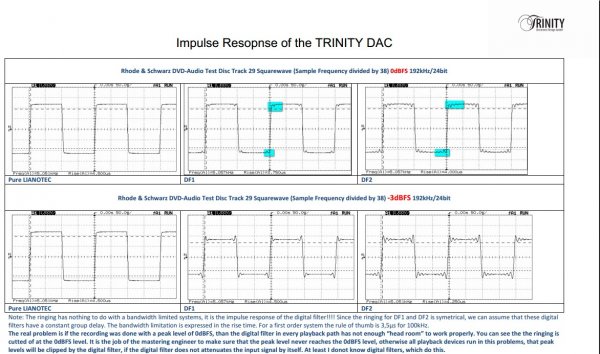I've seen this video quoted a number of times, and there have been plenty of threads in the past on it (which I only purused)... Before we get carried away, I think it's best to address the statement that "there is nothing inherently wrong with the resolution of the 16/44 format". My response is, THERE ABSOLUTELY IS, and Monty's video actually indirectly points out the issues. Here they are:
- Did you notice toward the end that the square wave input is not a square wave anymore at the output, after digital processing and reconstruction? He clearly says why: the signal is band-limited, thus the summation of all harmonics is "incomplete", causing the ripple effect he shows. This is a MAJOR inherent issue with digital, and consequently with RBCD, and higher sampling rates will reduce the band-limiting effect.
- When it comes to sineware processing, he correctly claims and demostrates that the difference between higher and lower number of bits is noise; he then discusses dither and noise shaping (which pushes noise up to higher frequencies). But what he does not say and show is what happens to noise with higher-than-16 bits, and naturally you would expect it to be even lower.
- He correctly states that lower noise results in wider dynamic range (letting you get closer to the theoretical limit of ~96dB for RBCD, not necessarily cross it); naturally, you would expect that even higher-than-16 bit resolution will result in even higher dynamic range - you might argue we don't need more, but I'd say this is yet another limitation of RBCD. [BTW, related to noise attenutation and dynamic headroom gain, under Steve's system thread, there is a discussion of how could he and Marty perceive louder overall sound with the Shunyata Typhons plugged in - and both Shunyata and I said basically the same thing: lower noise will result in higher dynamic headroom].
I like Monty's video, but as he says at the end, he has carefully chosen his demos - he's no fool. But let's not draw the wrong conclusions from his video.
But your ears are bandwidth limited. You can reproduce a few more harmonics, but your ears won't hear the extra harmonics.
And wider dynamic range, with peaks or signals out of the noise floor wouldn't sound louder. It has less average level and if the difference is enough to notice it sounds quieter. What many think of as wider dynamic range, is a more dynamic punchier sound. It actually is the reverse. That idea is where the loudness wars came from though they got out of hand and compress things so much all life is gone.











